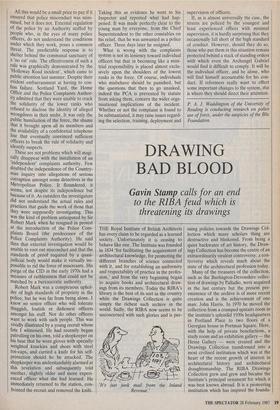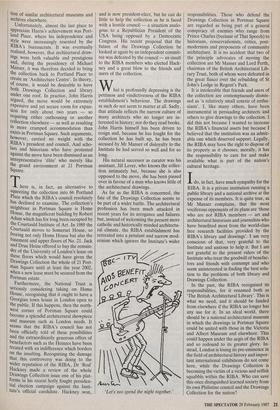DRAWING BAD BLOOD
Gavin Stamp calls for an end to the RIBA feud which is
threatening its drawings
THE Royal Institute of British Architects has every claim to be regarded as a learned society. Unfortunately it is ceasing to behave like one. The Institute was founded in 1834 'for facilitating the acquirement of architectural knowledge, for promoting the different branches of science connected with it, and for establishing an uniformity and respectability of practice in the profes- sion,' and from the very beginning began to acquire books and architectural draw- ings from its members. Today the RIBA's library is the best of its sort in the country while the Drawings Collection is quite simply the richest such archive in the world. Sadly, the RIBA now seems to be unconcerned with such glories and is pur- `It's just junk mail from the Inland Revenue.' suing policies towards the Drawings Col- lection which many scholars thing are destructive and blinkered. From being a quiet backwater of art history, the Draw- ings Collection has become the centre of an extraordinarily virulent controversy: a con- troversy which reveals much about the state of the architectural profession today.
Many of the treasures of the collection, such as the Burlington-Devonshire collec- tion of drawings by Palladio, were acquired in the last century but the present pre- eminence of the archive is of more recent creation and is the achievement of one man: John Harris. In 1970 he moved the collection from a cramped upstairs room in the institute's splendid 1930s headquarters in Portland Place to two floors of a Georgian house in Portman Square. Here, with the help of private benefactions, a study room and an exhibition gallery—the Heinz Gallery — were created and the Drawings Collection transformed into a most civilised institution which was at the heart of the recent growth of interest in architectural history and architectural draughtsmanship. The RIBA Drawings Collection grew and grew and became the Institute's principal ornament for which it was best known abroad. It is a pioneering institution which has inspired the founda- lion of similar architectural museums and archives elsewhere.
Unfortunately, almost the last place to appreciate Harris's achievement was Port- land Place, where his independence and style were increasingly resented by the RIBA's bureaucrats. It was eventually realised, however, that architectural draw- ings were both valuable and prestigious and, during the presidency of Michael Manser, it was therefore decided to bring the collection back to Portland Place to create an 'Architecture Centre'. In theory, of course, it would be desirable to have both Drawings Collection and library under one roof. In practice, John Harris argued, the move would be extremely expensive and yet secure room for expan- sion for only about two years — so requiring either outhousing or another collection elsewhere — as well as resulting in more cramped accommodation than exists in Portman Square. Such arguments, however, carried no weight with the RIBA's president and council. And scho- lars and historians who have protested against the move have been dismissed as an unrepresentative 'elite' who merely like the grand environment at 21 Portman Square.
There is, in fact, an alternative to squeezing the collection into 66 Portland Place which the RIBA's council resolutely has declined to examine. The collection's neighbour in Portman Square is Home House, the magnificent building by Robert Adam which has for long been occupied by the Courtauld Institute of Art. In 1989 the Courtauld moves to Somerset House, so freeing not only Home House but also the basement and upper floors of No. 21. Jack and Drue Heinz offered to buy the remain- der of the University of London's lease on these floors which would have given the Drawings Collection the whole of 21 Port- man Square until at least the year 2002, when a new lease must be secured from the Portman estate.
Furthermore, the National Trust is seriously considering taking on Home House, recognising that it ought to have a Georgian town house in London open to the public. If this happens, then the north- west corner of Portman Square could become a splendid architectural showpiece and museum such as London needs. It seems that the RIBA's council has not been officially told of these possibilities and the extraordinarily generous offers of benefactors such as the Heinzes have been treated with an indifference which borders on the insulting. Recognising the damage that this controversy was doing to the wider reputation of the RIBA, Dr 'Rod' Hackney made a review of the whole Drawings Collection issue one of his plat- forms in his recent hotly fought presiden- tial election campaign against the Insti- tute's official candidate. Hackney won, and is now president-elect, but he can do little to help the collection as he is faced with a hostile council — a situation analo- gous to a Republician President of the USA being opposed by a Democratic Congress. His recent proposal that the future of the Drawings Collection be looked at again by an independent commit- tee was defeated by the council — an insult to the RIBA members who elected Hack- ney and a great blow to the friends and users of the collection.
What is profoundly depressing is the pettiness and vindictiveness of the RIBA establishment's behaviour. The drawings as such do not seem to matter at all. Sadly, that attitude reflects the narrow culture of many architects who no longer are in- terested in history; nor do they read books. John Harris himself has been driven to resign and, because he has fought for the collection he has built up, he has been accused by Mr Manser of disloyalty to the Institute he had served so well and for so long.
His natural successor as curator was his assistant, Jill Lever, who knows the collec- tion intimately but, because she is also opposed to the move, she has been passed over in favour of a man who knows little of the architectural drawings.
As far as the RIBA is concerned, the fate of the Drawings Collection seems to be part of a wider battle. The architectural profession has been much attacked in recent years for its arrogance and failures but, instead of welcoming the present more catholic and historically minded architectu- ral climate, the RIBA establishment has retreated into a petulant and narrow mod- ernism which ignores the Institute's wider 'Let's not spend the night together.' responsibilities. Those who defend the Drawings Collection in Portman Square are regarded as being part of a general conspiracy of enemies who range from Prince Charles (because of That Speech) to historians, conservationists, critics, post- modernists and proponents of community architecture. It is no accident that two of the principle advocates of moving the collection are Mr Manser and Lord Perth, chairman of the British Architectural Lib- rary Trust, both of whom were defeated in the great fiasco over the rebuilding of St John's Lodge in Regent's Park.
It is intolerable that friends and users of the collection are contemptuously dismis- sed as 'a relatively small coterie of enthu- siasts'. I, like many others, have been instrumental in persuading architects and others to give drawings to the collection. I did this not because I wanted to increase the RIBA's financial assets but because I believed that the institution was an admir- able one which deserved support. Legally, the RIBA may have the right to dispose of its property as it chooses; morally, it has the responsibility to care for and make available what is part of the nation's cultural heritage.
Ido, in fact, have much sympathy for the RIBA. It is a private institution running a public library and a national archive at the expense of its members. It is quite true, as Mr Manser complains, that the most vociferous opponents of its plans are 'those who are not RIBA members — art and architectural historians and journalists who have benefited most from the world-class free research facilities provided by the RIBA's library and drawings'. I am very conscious of that, very grateful to the Institute and anxious to help it. But I am not grateful to the present rulers of the Institute who treat the goodwill of benefac- tors and friends with contempt and who seem uninterested in finding the best solu- tion to the problems of both library and Drawings Collection. In the past, the RIBA recognised its responsibilities, for it renamed both as `The British Architectural Library'. This is what we need, and it should be funded from elsewhere if the RIBA no longer has any use for it. In an ideal world, there should be a national architectural museum in which the drawings in Portman Square could be united with those in the Victoria and Albert Museum and elsewhere. This could happen under the aegis of the RIBA and so redound to its greater glory. In- stead, London is losing its pre-eminence in the field of architectural history and impor- tant international exhibitions do not come here, while the Drawings Collection is becoming the victim of a vicious and selfish squabble within the RIBA. Who can save this once disinguished learned society from its own Philistine council and the Drawings Collection for the nation?



















































 Previous page
Previous page